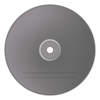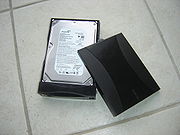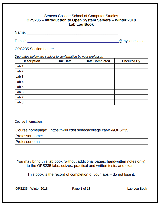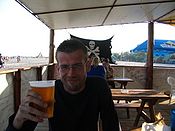Difference between revisions of "SEC520"
| Line 87: | Line 87: | ||
|Hard Disk Size: at least '''160GB'''.<br />'''Please buy the tray from ACS or the bookstore''' as not all trays are compatible.<br /><br />Mechanical shock from dropping a hard drive causes drive failure for several students each semester. If you use a mechanical hard drive, be careful not to drop it, and transport it in a padded container (e.g., a neoprene netbook sleeve, available from some dollar stores).<br /><br />Hard drives are currently expensive due to flooding in Thailand. Solid state disks (SSDs) are becoming competitive in price, are faster, and are less susceptible to shock, so you may want to look for a deal on an SSD instead of a hard drive -- but check to ensure that your SSD will fit properly into your drive tray.<br /><br />Please tighten the drive screws securely to prevent the tray from jamming in the holder, or leave the screws off.<br /><br /> | |Hard Disk Size: at least '''160GB'''.<br />'''Please buy the tray from ACS or the bookstore''' as not all trays are compatible.<br /><br />Mechanical shock from dropping a hard drive causes drive failure for several students each semester. If you use a mechanical hard drive, be careful not to drop it, and transport it in a padded container (e.g., a neoprene netbook sleeve, available from some dollar stores).<br /><br />Hard drives are currently expensive due to flooding in Thailand. Solid state disks (SSDs) are becoming competitive in price, are faster, and are less susceptible to shock, so you may want to look for a deal on an SSD instead of a hard drive -- but check to ensure that your SSD will fit properly into your drive tray.<br /><br />Please tighten the drive screws securely to prevent the tray from jamming in the holder, or leave the screws off.<br /><br /> | ||
|[[Image:hd-tray.jpg|thumb|right|180px|<b>Hard Disk in Disk Tray</b><br />At least <b>160 GB</b> (available at the Bookstore)]] | |[[Image:hd-tray.jpg|thumb|right|180px|<b>Hard Disk in Disk Tray</b><br />At least <b>160 GB</b> (available at the Bookstore)]] | ||
| − | |||
| − | |||
| − | |||
| − | |||
|} | |} | ||
Revision as of 09:38, 8 May 2012
| Quick Links |
|---|
| Course Outline [Security Resources] [Security Community] |
| Assignments |
| [Assignment 1]
[Assignment 2] |
Contents
Welcome to SEC520 - Internet Security
What This Course is About
This subject explores issues surrounding web site construction, operation, and maintenance from a security point of view. Student will learn how to:
- Identify attack types from both internal and external sources.
- Build secure servers ("hardened" servers).
Major topics will include document encryption, server protection, and defense strategies.
Demonstration web servers for both Windows and Unix/Linux will be investigated during this one semester course.
Learning by Doing
Most of the learning in this course occurs through the hands-on problem solving that takes place in the eight labs and two assignments.
Requirements for Success:
- It is very important to stay up-to-date with the coursework, and to practice until you have confidently mastered each task.
- All of the software used in this course is open source software, so you are free to use, modify, and redistribute it. This means that you can install it as many times as you want on as many different computers as you would like. It also means that you can tinker with it -- you can take it apart, see how it works, and put it back together in the same or a different way, limited only by your time and ambition. You are encouraged to experiment and question liberally.
- The notes that you make during the labs and assignments are your reference material for the quizzes, tests, and assignments. Take really good notes, and if you have questions, experiment and consult with your professor.
- Carefully read ALL lab instructions and check your work regularly. The labs have been designed with backup safeguards to prevent the student from losing their work. On the other hand, students may lose their work if they fail to follow lab instructions or accidentally forget their removable hard disks in the workstation's hard disk bay drive!
Course Resources
- SEC520 Weekly Schedule (Course Notes / Labs)
- Course Outline
- Course Policies
- School of Computer Studies Homepage
- [Security Resources]
- [Security Community]
Supplies Checklist (Required for Second Class)
1. Bootable Backtrack CD
| Storage Media | Download and Burning Options | Graphics | ||
|---|---|---|---|---|
| BackTrack Live CD (x86_64) (Used for "hardening" existing servers)
|
1. Burn BackTrack from Freedom Toaster (in the Open Lab) (click for details)
|
|||
2. Additional Hardware
| Item | Item Details | Graphic |
|---|---|---|
| SATA Hard Disk in Removable Drive Tray | Hard Disk Size: at least 160GB. Please buy the tray from ACS or the bookstore as not all trays are compatible. Mechanical shock from dropping a hard drive causes drive failure for several students each semester. If you use a mechanical hard drive, be careful not to drop it, and transport it in a padded container (e.g., a neoprene netbook sleeve, available from some dollar stores). Hard drives are currently expensive due to flooding in Thailand. Solid state disks (SSDs) are becoming competitive in price, are faster, and are less susceptible to shock, so you may want to look for a deal on an SSD instead of a hard drive -- but check to ensure that your SSD will fit properly into your drive tray. Please tighten the drive screws securely to prevent the tray from jamming in the holder, or leave the screws off. |
3. Study Aids
| Item | Item Details | Graphic |
|---|---|---|
| Lab Log-Book | Download and Print: Lab log book (PDF). Please note that you can use your log book during quizzes, written tests, practical tests and the final exam. It's also the record that you have completed the labs, so don't lose it! |
Important Information
Course Faculty
During the Winter 2012 semester, OPS235 is taught by:
|
And here's Andrew's timetable:
| Monday | Tuesday | Wednesday | Thursday | Friday | |
| 08:55 | |||||
| 09:50 | OPS235C | ||||
| 10:45 | OPS235C | ||||
| 11:40 | OPS235C | ||||
| 12:35 | OPS235C | OPS235A | |||
| 13:30 | OPS235A | OPS235A | |||
| 14:25 | OPS235A | ||||
| 15:20 | OPS235B | OPS235B | |||
| 16:15 | OPS235B | OPS235B |
Old Weekly Schedule (Do not use)
Wiki Participation
- You can edit these pages! Please feel free to fix typos or add links to additional resources. Please use this capability responsibly.





